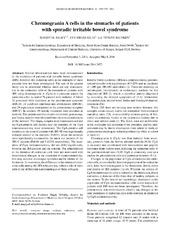| dc.contributor.author | El-Salhy, Magdy | en_US |
| dc.contributor.author | Gilja, Odd Helge | en_US |
| dc.contributor.author | Hausken, Trygve | en_US |
| dc.date.accessioned | 2015-09-23T06:59:30Z | |
| dc.date.available | 2015-09-23T06:59:30Z | |
| dc.date.issued | 2014-10 | |
| dc.identifier.issn | 1791-2997 | |
| dc.identifier.issn | 1791-3004 | |
| dc.identifier.uri | https://hdl.handle.net/1956/10503 | |
| dc.description.abstract | Several abnormalities have been demonstrated in the intestines of patients with irritable bowel syndrome (IBS); however, the endocrine cells in the stomachs of these patients have not been investigated. The aim of the present study was to determine whether there are any abnormalities in the endocrine cells of the stomachs of patients with IBS using chromogranin A (CgA) as a common marker for endocrine cells. A total of 76 patients were included, of which 26 presented with diarrhoea as the predominant symptom (IBS‑D), 21 exhibited diarrhoea and constipation (IBS‑M), and 29 experienced constipation as the predominant symptom (IBS‑C). In addition, 59 healthy volunteers were recruited as controls. The patients and the controls underwent gastroscopy, and biopsy samples were obtained from the antrum and corpus of the stomach. The biopsy samples were immunostained and the CgA‑positive cell density and the intensity of the CgA immunoreactivity were determined. The CgA‑positive cell densities in the antra of patients with IBS‑M were significantly reduced relative to the controls (P<0.01), while the densities were significantly increased in the antra and corpora of the IBS‑C patients (P<0.01 and P<0.001 respectively). The intensities of CgA immunoreactivity did not differ significantly between the IBS patients and the controls. The abnormalities in the densities of endocrine cells were not associated with concomitant changes in the intensities of immunoreactivity; this may indicate unchanged synthesis and/or release of the hormones. In conclusion, the difference in the density of endocrine cells among the IBS subtypes may reflect a role of these cells in the differential symptomologies of these subtypes. | en_US |
| dc.language.iso | eng | eng |
| dc.publisher | Spandidos | eng |
| dc.rights | Attribution CC BY | eng |
| dc.rights.uri | http://creativecommons.org/licenses/by/4.0 | eng |
| dc.subject | computer image analysis | eng |
| dc.subject | endocrine cells | eng |
| dc.subject | immunohistochemistry | eng |
| dc.subject | immunoreactivity intensity | eng |
| dc.title | Chromogranin A cells in the stomachs of patients With sporadic irritable bowel syndrome | en_US |
| dc.type | Peer reviewed | |
| dc.type | Journal article | |
| dc.date.updated | 2015-07-30T07:09:28Z | |
| dc.description.version | publishedVersion | en_US |
| dc.rights.holder | Copyright 2014 The Authors | |
| dc.identifier.doi | https://doi.org/10.3892/mmr.2014.2472 | |
| dc.identifier.cristin | 1161616 | |
| dc.source.journal | Molecular Medicine Reports | |
| dc.source.40 | 10 | |
| dc.source.14 | 4 | |
| dc.source.pagenumber | 1753-1757 | |
| dc.subject.nsi | VDP::Medisinske fag: 700::Klinisk medisinske fag: 750::Gasteroenterologi: 773 | |
| dc.subject.nsi | VDP::Midical sciences: 700::Clinical medical sciences: 750::Gastroenterology: 773 | |

